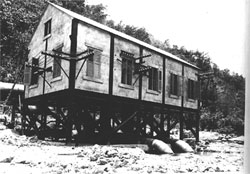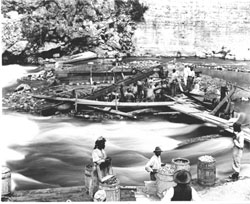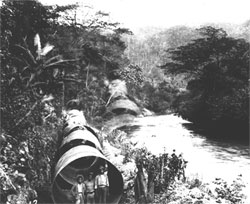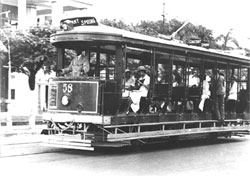|

Bog
Walk Tube
(In 1904: It was the largest pipe in the world - 6,200 feet long, 8 feet
in diameter, weighing 1,700,000 pounds, with 260,000 rivets holding it
together.)
 |
|
(
The power Station that housed the turbines which produced electricity.
The pipes shown brought water from the reservoir to the turbines
)
|
The early
morning of June 24, 1904 dawned clear
and crisp. In Spanish Town, St. Catherine, and other areas outside of
Kingston, men and women were lined up waiting to catch their tram to work
as usual. They waited until they realised it was not coming. The lucky
ones caught rides in wagonettes and buggies; the unlucky set out on foot.
No one was quite sure what had happened - only that there had been a temporary
delay that would soon be fixed. By the time eight o’clock rolled
around, wild rumours had begun to circulate about a horrible accident
at the Bog Walk Power Station that had affected the tram car system run
by the West India Electric Company.
It was said that up
to 80 men who had been cleaning silt and debris in the eight-foot long
cast iron pipe (also known as a flume) that carried water from the Rio
Cobre River to the Power Station, had been washed into the turbines and
drowned. The collection of silt and debris was not uncommon, nor was the
need for it to be removed so as not to inhibit the flow of water, and
therefore of hydroelectric power. Nothing like this had ever happened
before. By 9 o’clock, railway stations, newspaper offices, anywhere
information could possibly be found, were packed with anxious enquirers.
Much later, the only news to be had was that 33 coffins were sent out
to Bog Walk by train.
 |
|
(
Workers building the dam across the roaring Rio Cobre River )
|
The Accident
In Bog Walk, by this time, crowds had gathered at the Power Station. According
to Dr. Hammond, who was called to the scene, it was one he would never
forget as long as he lived: “men, women and children lying on the
ground, rolling over, clutching handfuls of grass, stones and earth, and
screaming aloud in the last extremities of mental agony” as they
searched for their loved ones who seemed to be lost to them forever. At
that time, 33 were believed dead and 17 missing. A few hours later, it
was confirmed that the 17 had managed to escape through a manhole near
to the dam itself. At one o’clock in the morning 61 men had gone
down into the huge pipe located about 15 yards from the power station.
The pipe curved slightly upward and then sharply downward running directly
into the power station itself. The men encountered about a foot of water
and got down to work as usual. Colin McDonald, one of the survivors, in
speaking to a Gleaner reporter at the scene, explained that within an
hour of going into the pipe he felt the water level rise but he didn’t
think it was anything to worry about. It couldn’t have been coming
from the dam because the dam was closed. It was always closed when the
men were working in the pipes. But the water kept rising slowly but surely
and by 4:00 a.m.,the men started to panic. Their supervisor, a Mr. Douparrouzel,
apparently tried to keep his men calm by telling them there was plenty
of time to get out - there was an exit closer to the dam. But his men
panicked and threw their torches into the water so that they were all
covered in darkness. Soon it was said a man appeared at the manhole with
a torch lighting the way and calling to the men. Twenty-eight managed
to get out in the over twenty minutes it took for the water to fill the
pipe. If they had listened and remained calm, site reports reveal, that
twenty minutes could have saved 300 men instead of 33.
 |
|
(
Three workers standing inside a section of the unassembled pipe
)
|
The remaining men
According to
Gleaner records of the event, Douparrouzel, distraught by the experience
and trying his best to come to terms with this catastrophe, could only
seem to say that the water must have over time swelled to the point where
it rushed over the sand and debris to flood the pipe. Although no one
lived to tell this tale, it is believed that three of the men located
in a very narrow section of the pipe, panic-stricken, Douparrouzel explained,
had tried to exit through a 2 foot 8 inch wide manhole at the same time
and effectively formed a human plug, entombing all 30 behind them. These
33 were found drowned, all heaped together, their clothes torn, their
faces and bodies completely mutilated.
Afterward
Within a few days, the tram car system was back in operation. Meanwhile
families who had lost fathers, brothers, cousins, tried to come to terms
with their losses. Although the West India Electric Company behaved very
sympathetically towards the families, helping to organise funeral services
and financial retribution,
the general feeling was that someone had blundered somewhere for that
level of water to have appeared. Ensuing investigations ruled the catastrophe
an accident, small consolation to the many who suffered great losses.
 |
|
(
The Constant Spring Tram running along King Street)
|
Today
Today the Bog Walk Power Station stands closed. In the 1930s the tram
car system was replaced by a bus system. The tram lines were uprooted
and replaced with wider roads. Some lines, such as the one at Cross Roads,
do still exist. The tramcars stopped running in 1948. As for the large
pipe in which so many were drowned alive, only a shell remains, preserving
the memory of the catastrophe on that June 24th morning.
-
Rebecca Tortello
All photographs courtesy of the Jamaica
Library Service.
|



